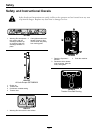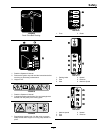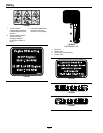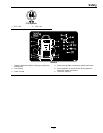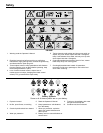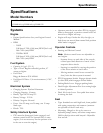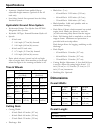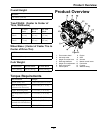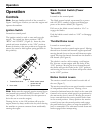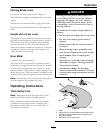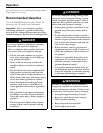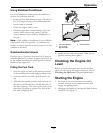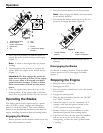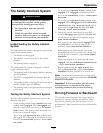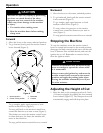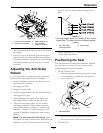
Operation
Operation
Controls
Note: Become familiar with all of the controls in
Figure 3 and Figure 4 before you start the engine and
operate the machine.
Ignition Switch
Located on control panel.
The ignition switch is used to start and stop the
engine. The switch has three positions “OFF”,
“RUN” and “START” ( Figure 4). Insert key into
switch and rotate clockwise to the “ON” position.
Rotate clockwise to the next position to engage the
starter (key must be held against spring pressure in
this position).
Figure 4
1. Throttle/Choke lever
3. Blade control switch
(power take-off)
2. Hour meter 4. Ignition switch
Note: Brake must be engaged, motion control levers
out (neutral lock position) and PTO switch “OFF” to
start engine. (It is not necessary for the operator to
be in the seat to start the engine.)
Turning the key to the Off position will stop the
engine; however, always remove the key when leaving
the machine to prevent someone from accidentally
starting the engine
Blade Control Switch (Power
Take-Off)
Located on the control panel.
The blade control switch, represented by a power
take-off (PTO) symbol, engages and disengages
power to the mower blades (see Figure 4).
Pull out on the blade control switch to “On” to
engage the blades.
Push the blade control switch to “Off” to disengage
the blades.
Throttle/Choke Lever
Located on control panel.
The throttle is used to control engine speed. Moving
throttle lever forward will increase engine speed and
moving throttle lever to the rear will decrease engine
speed. Moving the throttle forward into the detent is
full throttle (see Figure 4).
The choke is used to aid in starting a cold engine.
Do Not run a warm engine with the choke in the
“ON” position. Moving the lever forward beyond
the detent will put the choke in the “ON” position
and moving the lever to the detent will put the choke
in the “OFF” position.
Motion Control Levers
The motion control levers located on each side of
the seat (Figure 3).
The motion control levers are speed sensitive controls
of independent wheel motors. Moving a lever
forward or backward turns the wheel on the same side
forward or in reverse; wheel speed is proportional to
the amount the lever is moved. Moving the control
levers outward from the center position locks them
in the neutral position. Always position the motion
control levers into the neutral position and engage
the park brake lever when you stop the machine or
leave it unattended. The unit must be tied down and
brake engaged when transporting.
16



